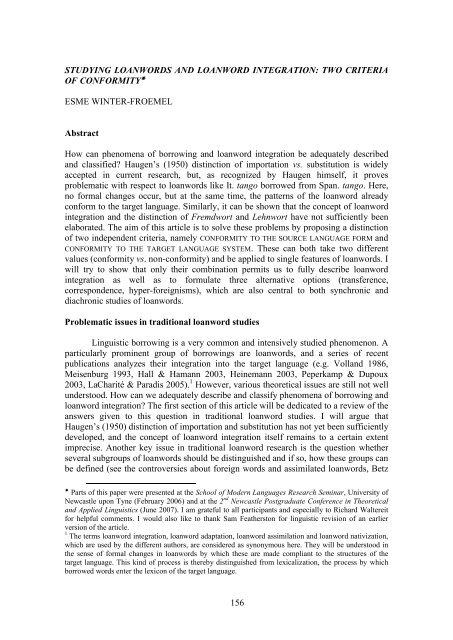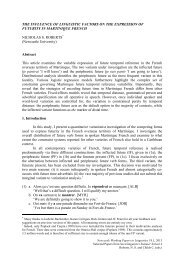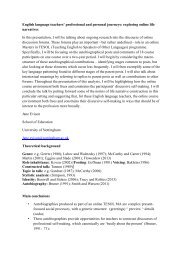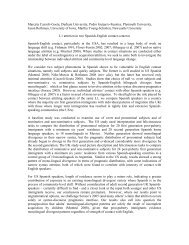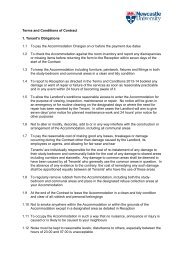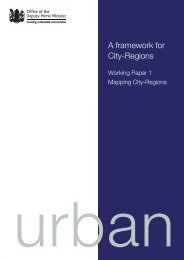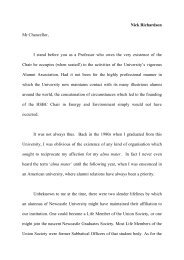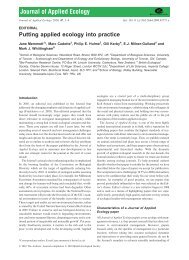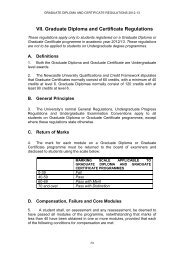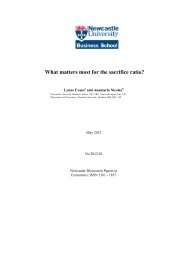156 STUDYING LOANWORDS AND LOANWORD INTEGRATION ...
156 STUDYING LOANWORDS AND LOANWORD INTEGRATION ...
156 STUDYING LOANWORDS AND LOANWORD INTEGRATION ...
Create successful ePaper yourself
Turn your PDF publications into a flip-book with our unique Google optimized e-Paper software.
<strong>STUDYING</strong> <strong><strong>LOANWORD</strong>S</strong> <strong>AND</strong> <strong>LOANWORD</strong> <strong>INTEGRATION</strong>: TWO CRITERIA<br />
OF CONFORMITY �<br />
ESME WINTER-FROEMEL<br />
Abstract<br />
How can phenomena of borrowing and loanword integration be adequately described<br />
and classified? Haugen’s (1950) distinction of importation vs. substitution is widely<br />
accepted in current research, but, as recognized by Haugen himself, it proves<br />
problematic with respect to loanwords like It. tango borrowed from Span. tango. Here,<br />
no formal changes occur, but at the same time, the patterns of the loanword already<br />
conform to the target language. Similarly, it can be shown that the concept of loanword<br />
integration and the distinction of Fremdwort and Lehnwort have not sufficiently been<br />
elaborated. The aim of this article is to solve these problems by proposing a distinction<br />
of two independent criteria, namely CONFORMITY TO THE SOURCE LANGUAGE FORM and<br />
CONFORMITY TO THE TARGET LANGUAGE SYSTEM. These can both take two different<br />
values (conformity vs. non-conformity) and be applied to single features of loanwords. I<br />
will try to show that only their combination permits us to fully describe loanword<br />
integration as well as to formulate three alternative options (transference,<br />
correspondence, hyper-foreignisms), which are also central to both synchronic and<br />
diachronic studies of loanwords.<br />
Problematic issues in traditional loanword studies<br />
Linguistic borrowing is a very common and intensively studied phenomenon. A<br />
particularly prominent group of borrowings are loanwords, and a series of recent<br />
publications analyzes their integration into the target language (e.g. Volland 1986,<br />
Meisenburg 1993, Hall & Hamann 2003, Heinemann 2003, Peperkamp & Dupoux<br />
2003, LaCharité & Paradis 2005). 1 However, various theoretical issues are still not well<br />
understood. How can we adequately describe and classify phenomena of borrowing and<br />
loanword integration? The first section of this article will be dedicated to a review of the<br />
answers given to this question in traditional loanword studies. I will argue that<br />
Haugen’s (1950) distinction of importation and substitution has not yet been sufficiently<br />
developed, and the concept of loanword integration itself remains to a certain extent<br />
imprecise. Another key issue in traditional loanword research is the question whether<br />
several subgroups of loanwords should be distinguished and if so, how these groups can<br />
be defined (see the controversies about foreign words and assimilated loanwords, Betz<br />
� Parts of this paper were presented at the School of Modern Languages Research Seminar, University of<br />
Newcastle upon Tyne (February 2006) and at the 2 nd Newcastle Postgraduate Conference in Theoretical<br />
and Applied Linguistics (June 2007). I am grateful to all participants and especially to Richard Waltereit<br />
for helpful comments. I would also like to thank Sam Featherston for linguistic revision of an earlier<br />
version of the article.<br />
1 The terms loanword integration, loanword adaptation, loanword assimilation and loanword nativization,<br />
which are used by the different authors, are considered as synonymous here. They will be understood in<br />
the sense of formal changes in loanwords by which these are made compliant to the structures of the<br />
target language. This kind of process is thereby distinguished from lexicalization, the process by which<br />
borrowed words enter the lexicon of the target language.<br />
<strong>156</strong>
157<br />
Winter-Froemel<br />
1959, 1974, 1975). I will argue that all three problematic issues can be overcome by<br />
distinguishing two criteria of conformity that can be applied to loanwords. The two<br />
criteria will then be discussed in more detail in section 0, where I will also propose a<br />
definition of Fremdwort (foreign word) and Lehnwort (assimilated loanword) that is<br />
based on these criteria. In section 0, I will finally argue that the criteria can be applied to<br />
the description of loanwords as well as to loanword integration, where they can each<br />
capture specific features of the linguistic items concerned.<br />
1.1 Haugen’s (1950) distinction of importation vs. substitution<br />
Haugen’s (1950) influential article on linguistic borrowing can still be<br />
considered as central for current studies of loanwords and loanword integration. Haugen<br />
distinguishes loanwords (e.g. AmE shivaree from Fr. charivari), loanblends (e.g. Fr.<br />
couronne jacket from Engl. jacket crown) and loanshifts (e.g. Fr. presqu’île modeled on<br />
Latin paeninsula; examples from Haugen 1950 and Blank 1995). As this article is<br />
concerned exclusively with the first group of borrowings, I will not comment on this<br />
distinction in detail here (see Winter in press). Of central importance for the concerns of<br />
this article, however, is the criterion that is used by Haugen to distinguish the three<br />
groups. He introduces the concepts of importation vs. substitution, which are defined as<br />
follows:<br />
If the loan is similar enough to the model so that a native speaker would accept it<br />
as his own, the borrowing speaker may be said to have IMPORTED the model into<br />
his language, provided it is an innovation in that language. But insofar as he has<br />
reproduced the model inadequately, he has normally SUBSTITUTED a similar<br />
pattern from his own language. This distinction between IMPORTATION and<br />
SUBSTITUTION applies not only to a given loan as a whole but to its constituent<br />
patterns as well, since different parts of the pattern may be treated differently.<br />
(Haugen 1950: 212).<br />
Let us consider an example where these terms are applied to the phonological<br />
patterns of borrowed words: in Span. estufa borrowed as [ehtúpa] by the Yaqui Indians<br />
(Haugen 1950: 215-216), various phonological substitutions occur. Haugen’s distinction<br />
seems very clear and easily applicable here. However, besides the two fundamental<br />
possibilities of importation and substitution, which are lengthily discussed in his article,<br />
Haugen briefly mentions a third option, which is characterized by partial correspondences<br />
between the languages, so that it becomes impossible to decide whether we are<br />
dealing with a case of importation or substitution: ‘If the loan contains patterns that are<br />
not innovations in the borrowing language, it becomes impossible to distinguish the two<br />
kinds of reproduction.’ (Haugen 1950: 213). An example for this latter case is the<br />
borrowing of Span. tango into Italian, where the form is not changed, so that there are<br />
no substitutions, but at the same time, no non-native elements are imported into Italian:<br />
(1) Span. tango > Ital. tango (DO, ZI, DELI) 2<br />
2 The full titles of the dictionaries that are cited can be found in the bibliography at the end of this article.
Winter-Froemel<br />
In my view, Haugen is addressing an important issue here, which, however, is<br />
not fully worked out in his article. This becomes clearer when we look back again at the<br />
definition of importation and substitution given above. The first part of the definition<br />
contains a COMPARISON OF THE SOURCE LANGUAGE FORM <strong>AND</strong> THE TARGET LANGUAGE<br />
FORM (‘If the loan is similar enough to the model so that a NATIVE speaker would accept<br />
it as his own,…’, Haugen 1950: 212, emphasis added). Then, however, Haugen adds a<br />
second, fundamentally different criterion, which refers to the STATUS OF THE IMPORTED<br />
ELEMENTS WITHIN THE SYSTEM OF THE TARGET LANGUAGE (‘…provided it is an<br />
innovation in that language.’, Haugen 1950: 212). 3<br />
In fact, the two aspects may appear to be closely linked to each other, as in many<br />
cases importations which are faithful to the source language (SL) form are innovations<br />
in the target language (TL) as well. Yet, there are also frequent cases in which they<br />
diverge. This is illustrated precisely by Ital. tango, whose phonological patterns are<br />
faithful to the SL form, but do not represent innovations in the TL. This suggests that<br />
Haugen’s definition does not cover all cases of borrowing. With respect to importation<br />
and substitution, I propose that these notions should be related to the first criterion<br />
exclusively, that is, to a comparison between the SL form and the TL form (see Winter<br />
in press). If an element (e.g. a word on the lexical level, or a phoneme on the<br />
phonological level) is kept during the borrowing process, it can be said to have been<br />
imported. Contrarily to Haugen, I assume that such an analysis is also possible for cases<br />
like Ital. tango, where we can state an importation of the word and its phonemes and<br />
graphemes. When we ask if certain patterns are new or already exist in the TL, in<br />
contrast, we are dealing with another issue.<br />
In a nutshell, we may distinguish two separate parameters on which loanwords<br />
can vary. As a result of our review of Haugen’s distinction, we have thus obtained two<br />
criteria which can each take two values:<br />
1) conformity vs. non-conformity to the source language (SL) form (importation vs.<br />
substitution), and<br />
2) conformity vs. non-conformity to the target language (TL) system.<br />
1.2 The notion of loanword integration<br />
To underline the importance of the two criteria, I shall now examine the notion<br />
of loanword integration itself. This term is commonly used to refer to processes like the<br />
following:<br />
(2) Engl. ski > Span. esquí (DLE, MOL)<br />
(3) Fr. béchamel > Ital. besciamella (DO, ZI)<br />
(4) Engl. meeting ['mi:tɪŋ] > Fr. meeting [mi'tiŋ] (PR, LAR)<br />
In examples (2)-(4), we can observe various changes in pronunciation, spelling<br />
and morphology. For example, an additional vowel is inserted in the borrowing of Engl.<br />
ski to Span. esquí for phonological/phonotactic reasons, and this change also becomes<br />
visible in spelling. In the borrowing of Fr. béchamel to Italian besciamella, there is a<br />
3 The two aspects are also mentioned in Humbley (1974: 47), but, at least as far as I can see, their<br />
distinction has not received appropriate attention in loanword studies up to now.<br />
158
Winter-Froemel<br />
1.3 The distinction of Fremdwort and Lehnwort<br />
Finally, serious controversies have arisen about the distinction of Fremdwort and<br />
Lehnwort. First of all, it has to be acknowledged that this distinction is not universally<br />
accepted. In English-speaking research, the category loanword is in general not<br />
subdivided. For example, Haugen (1950) makes no such distinction. In the Germanspeaking<br />
research tradition, however, an influential subdivision of the category<br />
Lehnwort has been proposed by Betz:<br />
Wird das Lehnwort in seiner fremden Lautgestalt bewahrt, so sprechen wir vom<br />
Fremdwort (Palais), wird es lautlich seiner neuen Umgebung angepaßt, von<br />
Lehnwort im eigentlichen Sinn (Pfalz). (Betz 1959: 128, see also Betz 1974,<br />
1975)<br />
If the loanword is kept in its foreign phonetic form, we speak of a foreign word<br />
([e.g. Germ.] Palais), if it is phonetically adapted to its new environment, of a<br />
loanword in the proper sense (Pfalz). 4<br />
His distinction between foreign words and assimilated loanwords is shown in<br />
Fig. 1:<br />
Fig. 1: The traditional distinction of two subcategories of loanwords (Betz 1959,<br />
1974, 1975)<br />
Fremdwort<br />
foreign word<br />
e.g. Germ. Palais (< Fr. palais)<br />
Lehnwort<br />
loanword<br />
� �<br />
vs.<br />
160<br />
Lehnwort (im eigentlichen Sinn)<br />
loanword (in the proper sense)<br />
e.g. Germ. Pfalz (< Fr. palais)<br />
However, this distinction has received various critical remarks. A first<br />
problematic aspect is the fact that the term Lehnwort is used ambiguously. On the one<br />
hand, when foreign words and loanwords are opposed to each other, the term is<br />
understood in the restricted sense of assimilated loanword (see also Carstensen 1968,<br />
Duckworth 1977, Kiesler 1993, Blank 1995). On the other hand, however, Lehnwort is<br />
also used as a general term comprising both foreign words and (assimilated) loanwords<br />
in the restricted sense. To overcome this terminological confusion, Duckworth (1977)<br />
and Kiesler (1993) have proposed the term entlehntes Wort (borrowed word) for the<br />
general category, but their proposal has not been widely adopted, and the term<br />
Lehnwort/loanword continues to be used in the general sense in most current research<br />
(see among others Blank 1995, Jacobs & Gussenhoven 2000, Hall & Hamann 2003,<br />
Peperkamp & Dupoux 2003, LaCharité & Paradis 2005). Similarly, in the remainder of<br />
this article, I will employ both <strong>LOANWORD</strong> and BORROWED WORD to refer to the general<br />
category.<br />
After this terminological clarification, I would like to discuss the delimitation of<br />
the two subcategories. Their distinction has been considered problematic (Scherner<br />
4 All translations of citations in this article are mine.
161<br />
Winter-Froemel<br />
1974: 264-267), and it has been concluded that ‘[…] it does not appear just how the line<br />
[between foreign words and assimilated loanwords] is to be drawn.’ (Haugen 1950:<br />
230). Various possible criteria have been discussed: sociolinguistic and stylistic criteria<br />
(which are adopted by von Polenz 1967: 72, but rejected by Duckworth 1977: 43), the<br />
question whether the words are borrowed for the first time or already lexicalized in the<br />
TL (see Gneuss 1955: 19), and structural factors. In the latter case, foreign words are<br />
defined as words containing non-native sounds, sound combinations, stress patterns,<br />
graphemes, etc., while no such elements appear in assimilated loanwords. These<br />
structural criteria have also been criticized (Gneuss 1955: 19, von Polenz 1967: 72), but<br />
they are generally regarded as decisive in current research (if Fremdwörter and<br />
Lehnwörter are distinguished at all, see Scherner 1974: 266-267, Blank 1995: 46).<br />
Besides their wide acceptance, structural factors offer the advantage of being<br />
characteristic for borrowed words only, while they are not pertinent to calques or<br />
loanshifts (Schottmann 1977: 26).<br />
Yet there is also a basic flaw in many definitions that are based on structural<br />
criteria. For example, the definition of Betz given above mixes up the two aspects that<br />
have been confronted in the preceding sections, that is, the question whether the<br />
borrowed form is changed from the SL form (‘…is kept in its … phonetic form’), and<br />
the question whether the features of the borrowed form correspond to the structures of<br />
the TL (‘…adapted to its new environment’). As we have already seen in 1.1, both<br />
aspects are in principle independent from each other. Therefore, it seems preferable to<br />
look for an alternative definition. A first possibility consists in referring to one of the<br />
criteria only. For example, Carstensen bases his definition on conformity towards the<br />
SL form exclusively. He defines a Fremdwort as a word which keeps the original<br />
spelling and pronunciation:<br />
Um die Scheidung in Fremd- und Lehnwort aufrechtzuerhalten, müssen wir von<br />
dieser Kategorie [Fremdwort] fordern, dass das aus dem Englischen kommende<br />
Sprachmaterial in Schreibung und Lautung seine ursprüngliche Form beibehält.<br />
(Carstensen 1968: 37).<br />
In order to maintain the distinction between foreign word and loanword, we have<br />
to demand of this category [the foreign word] that the linguistic material coming<br />
from English keeps its original form with respect to spelling and pronunciation.<br />
Other definitions, in contrast, only refer to the second aspect, correspondence to<br />
the structures of the TL, and consider foreign words as words that do not conform to<br />
certain structures (spelling, pronunciation) of the TL:<br />
[…] una palabra prestada de otro idioma es extranjerismo si la pronunciación y<br />
la grafía no corresponden a las reglas de pronunciación de la lengua receptora,<br />
mientras que es préstamo léxico si corresponden a estas reglas. (Kiesler 1993:<br />
508-510, compare Duckworth 1977: 46)<br />
[…] a word borrowed from another language is a foreign word if the<br />
pronunciation and the spelling do not correspond to the pronunciation rules of<br />
the receiving language, while it is a loanword if they correspond to these rules.<br />
The definitions of Carstensen and Kiesler both offer the advantage of being<br />
clear, since they do not mix up the two different aspects. Furthermore, in many cases
Winter-Froemel<br />
they lead to similar analyses, for example when applied to word pairs like the following,<br />
which may coexist within one language:<br />
(9) a. Fr. brioche > Ital. brioche (DO)<br />
b. Ital. brioscia (DO)<br />
While in both approaches the form in (9a), Ital. brioche, would be classified as a<br />
foreign word, the form in (9b), Ital. brioscia, would be analyzed as an assimilated<br />
loanword. However, there are also problematic examples:<br />
(10)a. Fr. bureau > Germ. Bureau [by'ro:]<br />
b. Germ. Büro [by'ro:]<br />
c. Germ. Büro ['bʏro]<br />
(DUDEN, EWDS, Munske 1983: 578-579, Nüssler 1987: 111)<br />
Here we have three TL forms. The form Bureau was mainly used in an earlier<br />
period of time, when the borrowing was recent. It is relatively unproblematic to analyze<br />
it as a foreign word, given that it closely corresponds to the SL form and at the same<br />
time contains patterns such as word-final stress and the graphemes and <br />
(corresponding to /o:/ and /y/ respectively), which are non-native with respect to the<br />
German system. 5 The latter two forms represent variants that are both largely used<br />
today. The last form can easily be analyzed as an assimilated loanword, as considerable<br />
changes with respect to the French form have taken place, and non-native patterns are<br />
substituted by native patterns (e.g. the form shows trochaic stress and contains the<br />
graphemes and corresponding to /o:/ and /y/). 6 Particularly problematic, however,<br />
is the middle form Germ. Büro [by'ro:], which is partially changed with respect to<br />
the French form, but at the same time, not fully integrated with respect to the German<br />
system. As Fig. 2 shows, the two criteria lead to divergent analyses here:<br />
5 Nevertheless, even here some objections could be made with respect to the first criterion: While we find<br />
the uvular fricative [ʁ] in French standard pronunciation, there are various allophones of the phoneme /r/<br />
in German that may be realized. It could be argued that the difference between these realizations is not<br />
phonologically relevant, and that a possible substitution is just a minimal change between parallel items<br />
from the systems of the SL and TL. With similar justifications, such substitutions are frequently passed<br />
over in studies of loanword integration (compare e.g. Volland 1986: 57). Another imperfection in the<br />
correspondence to the SL form concerns the first letter, which is changed into a capital letter in German<br />
Bureau. Carstensen (1968: 37) admits this particular type of orthographic change as an exception (which,<br />
however, could also be considered as problematic), so that, according to him, a classification as a foreign<br />
word is still possible.<br />
6 Nevertheless, in this case an objection to the second criterion could be made because of the final -o.<br />
However, Munske (1983: 577) argues that an elaborated vowel system of non-primary stress syllables<br />
already forms part of a central system of German, so that an analysis as an assimilated loanword seems<br />
possible.<br />
162
163<br />
Winter-Froemel<br />
Fig. 2: The distinction of foreign words and loanwords according to Carstensen<br />
(1968) and Kiesler (1993)<br />
distinction based<br />
on conformity to<br />
SL form<br />
(Carstensen)<br />
distinction based<br />
on conformity to<br />
TL system<br />
(Kiesler)<br />
foreign words (assimilated) loanwords<br />
Ital. brioche, Germ.<br />
Bureau [by'ro:] Germ. Büro [by'ro:]<br />
Ital. brioscia, Germ.<br />
Büro ['bʏro]<br />
= � =<br />
foreign words (ass.) loanwords<br />
Ital. brioche, Germ.<br />
Ital. brioscia, Germ.<br />
Bureau [by'ro:] Germ. Büro [by'ro:] Büro ['bʏro]<br />
Carstensen would analyze Germ. Büro [by'ro:] as an assimilated loanword, as<br />
the spelling is considerably changed with respect to the French form. According to the<br />
criterion adopted by Kiesler, in contrast, this form would be analyzed as a foreign word,<br />
as the stress pattern deviates from native German words. At this point it seems<br />
problematic to decide which criterion should be accorded priority, and which definition<br />
should be preferred. Furthermore, the general relation between the two criteria and the<br />
implications of their distinction need to be investigated in some more detail.<br />
Two criteria of conformity<br />
After laying out a distinction between two criteria of conformity that can be<br />
applied to loanwords and loanword integration, I now want to examine them more<br />
closely in order to specify their characteristics and show to what extent they can be seen<br />
as complementary. I will then discuss typical and ‘untypical’ combinations of specific<br />
values of both criteria, and return to the definition of foreign words and assimilated<br />
loanwords in order to propose a revised definition of these categories. Finally I will<br />
consider the diachronic development of borrowed forms in the TL and discuss how<br />
processes of loanword integration relate to the two criteria.<br />
1.1 Methodological aspects<br />
The first criterion that has been shown to be relevant for loanword studies is the<br />
criterion of CONFORMITY TO THE SOURCE LANGUAGE FORM. This criterion inherently<br />
involves language comparison, as it involves a comparison between SL forms and their<br />
TL equivalents. The second criterion of CONFORMITY TO THE TARGET LANGUAGE<br />
SYSTEM, in contrast, assesses the status of borrowed words or single features of<br />
borrowed words within the system of the TL. This means that a language-internal<br />
perspective is adopted. Thus, the distinction of the two criteria has important methodological<br />
corollaries. When studying conformity to the SL form, the main goal consists in<br />
establishing relations between SL and TL elements, e.g. phonemes or graphemes. This<br />
means that a previous segmentation of the SL and TL forms is required:
165<br />
Winter-Froemel<br />
- nonconformity to the SL form + conformity to the TL system (NCSF + CTS) =<br />
<strong>LOANWORD</strong> <strong>INTEGRATION</strong> and<br />
- conformity to the SL form + non-conformity to the TL system (CSF + NCTS) =<br />
TRANSFERENCE.<br />
These combinations, however, leave open two alternative options, which are<br />
often not clearly indicated in research literature:<br />
- conformity to the SL form + conformity to the TL system (CSF + CTS) =<br />
CORRESPONDENCE and<br />
- nonconformity to the SL form + nonconformity to the TL system (NCSF +<br />
NCTS) = HYPER-FOREIGNISMS.<br />
Combining the two criteria, we thus obtain a simple and more comprehensive<br />
system for analyzing loanwords. Fig. 3 provides an overview of the four options:<br />
Fig. 3: Possible combinations of the two types of conformity<br />
conformity to the<br />
target language<br />
system (CTS)<br />
non-conformity to<br />
the target language<br />
system (NCTS)<br />
conformity to the source<br />
language form (CSF)<br />
CORRESPONDENCE:<br />
/t, a,…/, , ,… in Ital. tango<br />
(< Span. tango), , in Fr.<br />
wagon (< Engl. wagon)<br />
TRANSFERENCE:<br />
in Fr. wagon<br />
(< Engl. wagon)<br />
non-conformity to the source<br />
language form (NCSF)<br />
<strong>LOANWORD</strong> <strong>INTEGRATION</strong>:<br />
in Span. esquí<br />
(< Engl. ski)<br />
HYPER-FOREIGNISMS:<br />
in Fr. bifteck<br />
(< Engl. beef steak)<br />
The first option is represented by CORRESPONDENCE: a certain structure of a<br />
borrowed item may conform to the system of the TL without being changed from the<br />
original form. This option is very frequent in closely related languages, like e.g. Spanish<br />
and Italian, as the borrowing of tango illustrates. In this example, all phonemes and<br />
graphemes are both conform to the original Spanish form and to the Italian language<br />
system. Nevertheless, even if such nearly perfect correspondences are relatively rare,<br />
there are many cases of partial correspondences, in which certain elements of the<br />
borrowed form can be kept during the borrowing process without deviating from the TL<br />
system. In the borrowing of Engl. wagon to Fr. wagon (PR, LAR), the graphemes <br />
and as well as the phonemes /g/ and /n/ illustrate such correspondences.<br />
However, in this borrowing we can also detect a second option, the conservation<br />
of non-native structures or TRANSFERENCE (Volland 1986). The grapheme is kept<br />
in the borrowing process as well, but contrarily to and , it does not conform to<br />
the graphematic system of French (in fact, it only occurs in borrowed forms).<br />
In other cases, non-native structures may not be tolerated, that is, they may be<br />
changed to conform to the system of the TL. This option of <strong>LOANWORD</strong> <strong>INTEGRATION</strong> is<br />
illustrated by many of the examples cited above, e.g. Span. esquí, where is<br />
substituted by . Furthermore, an epenthesis is realized, which is reflected by the<br />
spelling of the Spanish form ( added).<br />
Finally, there are cases in which elements of a borrowed item are substituted by<br />
other elements which themselves do not conform to the native structures of the<br />
borrowing language (HYPER-FOREIGNISMS, see Hock & Joseph 1996: 270). For example,
Winter-Froemel<br />
the grapheme in Fr. bifteck (PR, LAR, DHLF) can neither be explained by<br />
referring to the English form (containing ), nor can it be led back to an integration<br />
process yielding an integrated form (as is non-native with respect to the<br />
graphematic system of French). Certainly such substitutions are not very frequent, and<br />
in fact they are not mentioned in most traditional and current studies of loanwords.<br />
Nevertheless, recent studies show that they can be observed in a broad range of<br />
languages (e.g. Janda, Joseph & Jacobs 1994), which provides further evidence for the<br />
usefulness of distinguishing and combining the two criteria.<br />
1.3 The definition of Fremdwort and Lehnwort in the restricted sense<br />
In 1.3, I have left open the question of how Fremdwort and Lehnwort in the<br />
restricted sense should be defined. More precisely, I have left open the question whether<br />
one of the two criteria of conformity should be accorded priority, and if so, which.<br />
Reconsidering the different options given in Fig. 3 and the traditional use of the concept<br />
‘loanword integration’, I propose to regard conformity to the TL system as decisive.<br />
That is, Fremdwörter can be defined as words which fall either partially or fully into the<br />
category of transference. They keep at least one element of non-native structure in the<br />
borrowing process (e.g. word-final stress as in Germ. Büro [by'ro:]), while Lehnwörter<br />
in the restricted sense entirely conform to the TL system (e.g. Ital. tango).<br />
However, this does by no means imply that the criterion of conformity to the SL<br />
form is completely rejected. On the contrary, it seems possible to combine it with the<br />
other criterion and to introduce further subdivisions. Thereby we can distinguish nonintegrated<br />
Fremdwörter (e.g. Ital. brioche) vs. partially integrated Fremdwörter (e.g.<br />
Germ. Büro [by'ro:]) and Lehnwörter by correspondence (e.g. Ital. tango) vs.<br />
Lehnwörter by integration (e.g. Ital. brioscia).<br />
1.4 The diachronic development of borrowed words<br />
As illustrated in Fig. 3 above, the combination of the criteria permits us to<br />
capture the different processes that may occur during the situation of linguistic<br />
borrowing proper, when a TL speaker borrows a certain expression and uses it for the<br />
first time in the TL. In addition, I shall now argue that both criteria can also be applied<br />
to the further development of borrowed items in the TL, that is, to processes by which a<br />
borrowed item may be increasingly adapted to the structures of the TL (recall the<br />
example of Germ. Büro cited above in (10) as well as examples (5)-(8)). The following<br />
proposals to change borrowed words provide further examples (in the case of Queneau,<br />
with clearly humoristic intentions):<br />
(14) Fr. snobe (instead of snob, Etiemble 1964: 316)<br />
(15) Fr. tiquet (instead of ticket, Etiemble 1964: 316)<br />
(16) Fr. guidenappeur (instead of kidnapper, R. Queneau, Zazie: 108)<br />
(17) Fr. bloudjinnzes (instead of blue jeans, R. Queneau, Zazie: 48)<br />
As we enter a temporal dimension here, the two criteria of conformity are<br />
combined with a further, chronological aspect. This means that we obtain altogether<br />
three aspects that are relevant for loanword studies. They can be opposed as<br />
comparative (criterion of conformity to the SL form), synchronic-internal (criterion of<br />
166
171<br />
Winter-Froemel<br />
Fig. 5: An analysis of Germ. Bureau according to the two criteria of conformity<br />
graphemes<br />
Fr. < b u r eau ><br />
Germ. < B u r eau ><br />
CSF / NCSF NCSF CSF CSF CSF<br />
CTS / NCTS CTS CTS CTS NCTS<br />
phonemes<br />
Fr. / b y r o /<br />
Germ. / b y r o: /<br />
CSF / NCSF CSF CSF CSF NCSF<br />
CTS / NCTS CTS CTS CTS CTS<br />
grapheme-phoneme-correspondences<br />
Germ. ↔ /b/ ↔ /y/ ↔ /r/ ↔ /o:/<br />
CTS / NCTS CTS NCTS CTS NCTS<br />
word stress<br />
Fr. σ 'σ<br />
Germ. σ 'σ<br />
CSF / NCSF CSF<br />
CTS / NCTS NCTS<br />
In addition to the phonemes and graphemes, the table includes the graphemephoneme-correspondences<br />
and word stress, as these patterns undergo changes in the<br />
further processes of integration. Our analysis permits us again to sort out all<br />
instantiations of the different combinations:<br />
CFS + CTS (CORRESPONDENCE): , <br />
/b/, /y/, /r/ 11<br />
NCFS + CTS (<strong>LOANWORD</strong> <strong>INTEGRATION</strong>): � <br />
/o/ � /o:/<br />
CFS + NCTS (TRANSFERENCE): <br />
σ 'σ<br />
to which the grapheme-phoneme-correspondences, possible and impossible in the TL,<br />
can be added:<br />
CTS: ↔ /b/, ↔ /r/<br />
NCTS: ↔ /y/, ↔ /o:/<br />
As I have argued above, the first criterion is not analyzed for graphemephoneme-correspondences,<br />
since they are only indirectly influenced by the SL form.<br />
Such a treatment is additionally justified by the example of ↔ /y/, which shows<br />
that we can have grapheme-phoneme-correspondences that do not conform to the TL<br />
even if the concerned graphemes and phonemes themselves are conform to it. Nonnative<br />
graphemes or phonemes are therefore a sufficient (cf. ↔ /o:/), but not a<br />
11 I do not consider here changes in phonetic realization that are not phonologically relevant (e.g.<br />
concerning the different allophones of the phoneme /r/ in German).
Winter-Froemel<br />
necessary (cf. ↔ /y/) condition for having non-native grapheme-phonemecorrespondences.<br />
The application of the two criteria has provided a detailed analysis of the<br />
originally borrowed form Germ. Bureau. Now it is interesting to consider the further<br />
development of this form in the TL. While the structures which conform to the TL<br />
system (correspondences, loanword integrations) should be expected not to change, the<br />
structures still exhibiting non-native features can be assumed to be potentially affected<br />
by further integration processes. And in fact, in the further development of the form,<br />
these latter features systematically disappear. In Germ. Büro [by'ro:], the graphemes<br />
and are substituted by the TL conform graphemes and , so that TL<br />
conform grapheme-phoneme-correspondences ( ↔ /y/, ↔ /o:/) are yielded.<br />
These changes leave open only one feature that still does not conform to the TL: the<br />
stress pattern. And in fact, the word-final accent is changed into a native stress pattern<br />
('σ σ) in a further step of integration, by which the form Germ. Büro ['bʏro] is obtained.<br />
In addition, this change in word stress triggers an opening of the vowel and a loss of<br />
vowel length (/y:/ � /ʏ/, compare Volland 1986).<br />
In short, according to our expectations, processes of progressive loanword<br />
integration act upon certain structures of loanwords only, while other structures, which<br />
are already compliant to the TL, are not affected. The distinction and combination of the<br />
two criteria of conformity therefore may contribute to a better understanding of<br />
diachronic processes of progressive integration of loanwords, as it permits us to locate<br />
these processes more precisely within the forms concerned.<br />
Concluding remarks<br />
Our review of the traditional literature on linguistic borrowing and loanword<br />
integration has shown that several fundamental issues have remained problematic up to<br />
now. Haugen’s distinction of importation and substitution is widely accepted, but, as<br />
Haugen himself acknowledges, it raises problems when applied to certain kinds of<br />
loanwords. In a similar way, the concept of loanword integration has not sufficiently<br />
been elaborated, and the distinction of Fremdwort and Lehnwort in the restricted sense<br />
has given rise to controversial discussions. In order to solve these problems, I have<br />
argued that we should distinguish two types of conformity that can be assessed in<br />
studies of loanwords and loanword integration: CONFORMITY TO THE SOURCE LANGUAGE<br />
FORM and CONFORMITY TO THE TARGET LANGUAGE SYSTEM. The criteria can each take<br />
two possible values (conformity vs. nonconformity). Both have been referred to in<br />
earlier studies, but they have not been systematically opposed to each other and<br />
combined up to now. I have tried to show that their distinction not only permits us to<br />
reconsider well-known cases of <strong>LOANWORD</strong> <strong>INTEGRATION</strong> and TRANSFERENCE, but also<br />
to focus on CORRESPONDENCES as well as HYPER-FOREIGNISMS. In addition, the criteria<br />
can be used to refer to both the initial stage of linguistic borrowing and further<br />
developments of borrowed words within the TL. In a nutshell, they can be applied to<br />
both synchronic and diachronic issues, and they may thus permit us to describe more<br />
precisely the structure of loanwords and phenomena of loanword integration.<br />
172
References:<br />
173<br />
Winter-Froemel<br />
Betz, W. (1959). Lehnwörter und Lehnprägungen im Vor- und Frühdeutschen. In<br />
Maurer, F. & Stroh, F. (eds.), Deutsche Wortgeschichte. 2., neubearbeitete<br />
Auflage, Bd. I, 127-147. Berlin: de Gruyter.<br />
Betz, W. (1974). Lehnwörter und Lehnprägungen im Vor- und Frühdeutschen. In<br />
Maurer, F. & Rupp, H. (eds.), Deutsche Wortgeschichte. 3., neubearbeitete Auflage,<br />
Vol. I, 135-163. Berlin, New York: de Gruyter.<br />
[Betz, W.] (1975). Lehnwortschatz. In Stammerjohann, H. (ed.), Handbuch der<br />
Linguistik. Allgemeine und angewandte Sprachwissenschaft, 250-251. München:<br />
Nymphenburger.<br />
Blánar, V. (1968). Die Einbürgerung entlehnter Wörter in graphischer Darstellung.<br />
Travaux linguistiques de Prague 3, 155-178.<br />
Blank, A. (1995). Lexikalische Entlehnung – Sprachwandel – Sprachvergleich:<br />
Beispiele aus dem Computer-Wortschatz. In Schmitt, C. & Schweickard, W.<br />
(eds.), Die romanischen Sprachen im Vergleich. Akten der gleichnamigen<br />
Sektion des Potsdamer Romanistentags, 38-69. Bonn: Romanistischer Verlag.<br />
Carstensen, B. (1968). Zur Systematik und Terminologie deutsch-englischer Lehnbeziehungen.<br />
In Brekle, H. E. & Lipka, L. (eds.), Wortbildung, Syntax und Morphologie.<br />
Festschrift zum 60. Geburtstag von Hans Marchand am 1. Oktober 1967,<br />
32-45. The Hague, Paris: Mouton.<br />
Carstensen, B. (1981). Lexikalische Scheinentlehnungen des Deutschen aus dem Englischen.<br />
In Kühlwein, W. et al. (eds.), Kontrastive Linguistik und Übersetzungswissenschaft.<br />
Akten des Internationalen Kolloquiums Trier/Saarbrücken, 25. –<br />
30.9.1978, 175-182. München: Fink.<br />
Clahsen, H. et al. (1992). Regular and irregular inflection in the acquisition of German<br />
noun plurals. Cognition 45, 225-255.<br />
CLC = Ramsay, S. & Lozano-Hemmer, R. Ciber-Lexico Comparativo. Comparative<br />
CyberLexicon. . Updated on 05-07-<br />
2001.<br />
Daneš, F. (1966). The Relation of Center and Periphery as a Language Universal.<br />
Travaux linguistiques de Prague 2, 9-21.<br />
DELI = Cortelazzo, M. & Zolli, P. (1999). Il nuovo etimologico. DELI – Dizionario<br />
etimologico della lingua italiana. 2 nd ed. Bologna: Zanichelli.<br />
DHLF = Rey, A. (1998). Dictionnaire historique de la langue française. 3 Vols. Paris:<br />
Dictionnaires Le Robert.<br />
DICIO = Ferreira, A. M. C. Dicionário do Internetês.<br />
. Updated on 08-18-1995.<br />
DLE = Real Academia Española (1992). Diccionario de la lengua española. 21 st ed.<br />
Madrid: Espasa Calpe.<br />
DO = Devoto, G. & Oli, G. C. (2000). Il Dizionario della lingua italiana. Edizione<br />
2000-2001 con CD-ROM. Firenze: Le Monnier.<br />
Duckworth, D. (1977). Zur terminologischen und systematischen Grundlage der Forschung<br />
auf dem Gebiet der englisch-deutschen Interferenz. Kritische Übersicht<br />
und neuer Vorschlag. In Kolb, H. & Lauffer, H. (eds.), Sprachliche Interferenz.<br />
Festschrift für Werner Betz zum 65. Geburtstag, 36-56. Tübingen: Niemeyer.<br />
DUDEN = Duden. Rechtschreibung der deutschen Sprache(1996). 21., völlig neu<br />
bearbeitete und erweiterte Auflage. Herausgegeben von der Dudenredaktion.
175<br />
Winter-Froemel<br />
LaCharité, D. & Paradis, C. (2005). Category Preservation and Proximity versus<br />
Phonetic Approximation in Loanword Adaptation. Linguistic Inquiry 36/2, 223-<br />
258.<br />
LAR = Le Petit Larousse illustré (1999). Paris: Larousse.<br />
Meisenburg, T. (1993). Graphische und phonische Integration von Fremdwörtern am<br />
Beispiel des Spanischen. Zeitschrift für Sprachwissenschaft 11, 47-67.<br />
Meisenburg, T. (1996). Romanische Schriftsysteme im Vergleich. Eine diachrone<br />
Studie. Tübingen: Narr.<br />
MOL = Moliner, M. (1994). Diccionario de uso del español. 2 Vols. 2 nd ed. Madrid:<br />
Gredos.<br />
Munske, H. H. (1983). Zur Fremdheit und Vertrautheit der ‘Fremdwörter’ im Deutschen.<br />
In Peschel, D. (ed.), Germanistik in Erlangen. Hundert Jahre nach der<br />
Gründung des Deutschen Seminars, 559-595. Erlangen: Universitätsbund<br />
Erlangen-Nürnberg.<br />
Munske, H. H. (1988). Ist das Deutsche eine Mischsprache? Zur Stellung der Fremdwörter<br />
im deutschen Sprachsystem. In Munske, H. H. et al. (eds.), Deutscher<br />
Wortschatz. Lexikologische Studien. Ludwig Erich Schmitt zum 80. Geburtstag<br />
von seinen Marburger Schülern, 46-74. Berlin, New York: de Gruyter.<br />
Nüssler, O. (1987). Zum Problem einer Reform der Fremdwortorthographie aus der Perspektive<br />
der Fachsprachen. In Zabel, H. (ed.), Fremdwortorthographie. Beiträge<br />
zu historischen und aktuellen Fragestellungen, 111-125. Tübingen: Niemeyer.<br />
OALD = Oxford Advanced Learner’s Dictionary (1989). Oxford: Oxford University<br />
Press.<br />
Peperkamp, S. & Dupoux, E. (2003). Reinterpreting loanword adaptations: The role of<br />
perception. Proceedings of the 15th International Congress of Phonetic Sciences<br />
2003, 367-370.<br />
Polenz, P. von (1967). Fremdwort und Lehnwort sprachwissenschaftlich betrachtet.<br />
Muttersprache 77, 65-80.<br />
PR = Rey, A. & Rey-Debove, J. (2000). Le nouveau Petit Robert. Dictionnaire alphabétique<br />
et analogique de la langue française. Paris: Dictionnaires Le Robert.<br />
Rose, Y. & Demuth, K. (2006). Vowel epenthesis in loanword adaptation: Representational<br />
and phonetic considerations. Lingua 116, 1112-1139.<br />
Scherner, M. (1974). Die Begriffe zur Gliederung des sprachlichen Lehngutes. Archiv<br />
für Begriffsgeschichte 18, 262-282.<br />
Schottmann, H. (1977). Die Beschreibung der Interferenz. In Kolb, H. & Lauffer, H.<br />
(eds.), Sprachliche Interferenz. Festschrift für Werner Betz zum 65. Geburtstag,<br />
13-35. Tübingen: Niemeyer.<br />
Uspensky, B. A. & Zhivov, V. M. (1977). Center-Periphery Opposition and Language<br />
Universals. Linguistics 196, 5-24.<br />
Vachek, J. (1966). On the Integration of the Peripheral Elements into the System of<br />
Language. Travaux linguistiques de Prague 2, 23-37.<br />
Vendelin, I. & Peperkamp, S. (2006). The influence of orthography on loanword<br />
adaptations. Lingua 116, 996-1007.<br />
Volland, B. (1986). Französische Entlehnungen im Deutschen. Transferenz und Integration<br />
auf phonologischer, graphematischer, morphologischer und lexikalischsemantischer<br />
Ebene. Tübingen: Niemeyer.
Winter-Froemel<br />
Wegener, H. (1999). Die Pluralbildung im Deutschen – ein Versuch im Rahmen der<br />
Optimalitätstheorie. Linguistik online 4, 3/99. .<br />
Wegener, H. (2002). Zur Funktion des s-Plurals im heutigen Deutsch. In Wiesinger, P.<br />
(ed.), Akten des X. Internationalen Germanistenkongresses Wien 2000 „Zeitenwende<br />
– Die Germanistik auf dem Weg vom 20. ins 21. Jahrhundert“. Vol. 2:<br />
Entwicklungstendenzen der deutschen Gegenwartssprache. Lexikologie und<br />
Lexikographie, 109-116. Bern et al.: Lang.<br />
Wegener, H. (2003). Normprobleme bei der Pluralbildung fremder und nativer<br />
Substantive. Linguistik online 16, 4/03. .<br />
Wegener, H. (2004). Pizzas und Pizzen – die Pluralformen (un)assimilierter Fremdwörter<br />
im Deutschen. Zeitschrift für Sprachwissenschaft 23, 47-112.<br />
Wichmann, S. & Wohlgemuth, J. (in press). Loan verbs in a typological perspective. In<br />
Stolz, T., Palomo, R. & Bakker, D. (eds.), Romancisation Worldwide. Berlin,<br />
New York: Mouton de Gruyter.<br />
(15.2.2006).<br />
Wienold, G. (1968). Sprachlicher Kontakt und Integration. Zeitschrift für Mundartforschung<br />
35, 209-218.<br />
Winter, E. (2005). Zum Verhältnis sprachkontaktinduzierter Innovationen, lexikalischer<br />
Entlehnungen und fremder Wörter – zugleich ein Beitrag zu ‘Lehnschöpfung’<br />
und ‘Scheinentlehnung’. Romanistisches Jahrbuch 56, 31-62.<br />
Winter, E. (in press). Ital. browser = span. hojeador = frz. butineur? Strategien des<br />
Umgangs mit sprachlicher Fremdheit im Kontext von Entlehnung und Übersetzung.<br />
In Gramatzki, S. et al. (eds.), Trennstrich oder Brückenschlag? Über-<br />
Setzen als literarisches und linguistisches Phänomen. Beiträge zum XX. Forum<br />
Junge Romanistik, Wuppertal, 2. – 5. Juni 2004. Bonn: Romanistischer Verlag.<br />
Zazie = Queneau, R. (1959): Zazie dans le métro. Paris: Folio.<br />
ZI = Zingarelli, N. (2000): Lo Zingarelli 2001. Vocabolario della lingua italiana. 12 th<br />
ed. Bologna: Zanichelli.<br />
Esme Winter-Froemel<br />
Romanisches Seminar<br />
Universität Tübingen<br />
Wilhelmstraße 50<br />
D-72074 Tübingen<br />
Germany<br />
esme.winter-froemel@uni-tuebingen.de<br />
176


